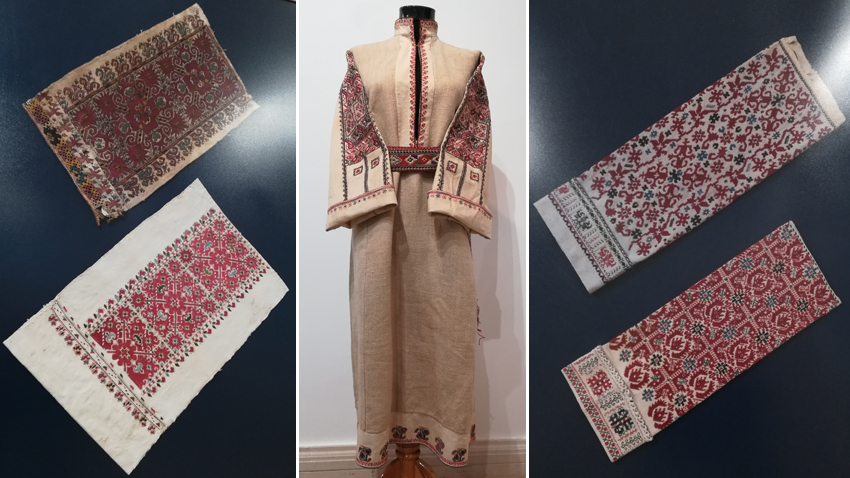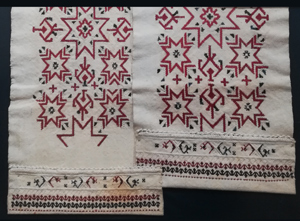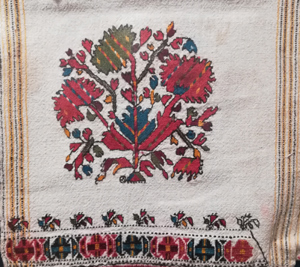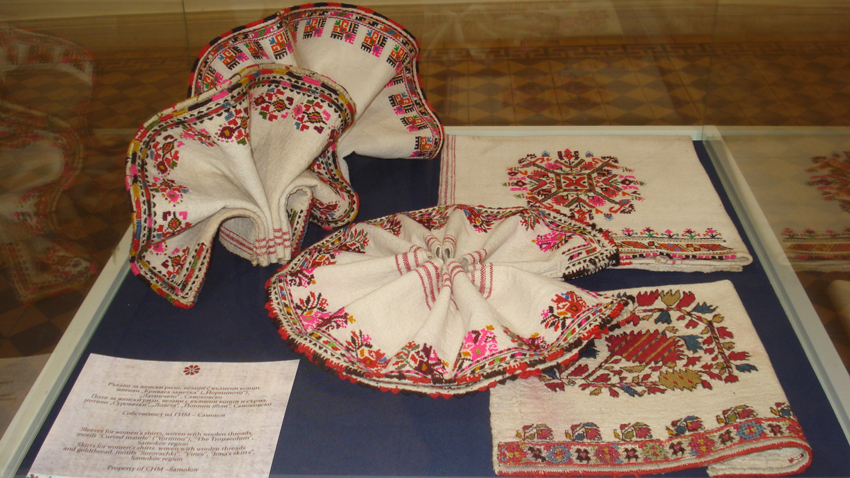An exhibition has opened in Sofia with the motto “The memory of Sofia embroidery patterns” dedicated to the 90th anniversary of the Regional Museum of History in the capital city. The display features a diverse heritage of embroidery work made in the villages on the outskirts of Sofia which later spread as patterns to the entire region. The current selection incudes samples from the end-19th and the early 20th centuries. More about Sofia embroidery and their characteristic color varieties and ornaments, from the curator of the exhibition Katelina Pavlova.
"The Sofia embroidery is part of the traditions of the Bulgarian embroidery and as such is part of the cultural and historical heritage. It is called ‘svilenitsa’ and features a typical wine-red color. In the distant past this kind of embroidery was originally made from homemade and dyed silk where its name comes from (‘svila’ means silk), although in the 19th century and the early 20th century the masters of embroidery already used predominantly cotton and woolen threads."

 "A peculiarity of the Sofia embroidery pieces is that they were applied on the sleeves of women’s shirts from the shoulder to the wrist. Designs also stand out with the diamond-shaped and square floral and animal motifs arranged either horizontally or diagonally across the sleeves. An interesting detail of embroidery work in the region of Sofia is the use of the eight-leaved rosette and its transformation into an eight-pointed star (elbetitsa).”
"A peculiarity of the Sofia embroidery pieces is that they were applied on the sleeves of women’s shirts from the shoulder to the wrist. Designs also stand out with the diamond-shaped and square floral and animal motifs arranged either horizontally or diagonally across the sleeves. An interesting detail of embroidery work in the region of Sofia is the use of the eight-leaved rosette and its transformation into an eight-pointed star (elbetitsa).”
 Not all stitches used by Sofia embroidery masters have survived to the present day. Some have been lost, others are hard to decode, because the embroidered items are severely damaged by time and it is not clear where the thread ran.
Not all stitches used by Sofia embroidery masters have survived to the present day. Some have been lost, others are hard to decode, because the embroidered items are severely damaged by time and it is not clear where the thread ran.
„Today some 20 stitches are in use, and five to six are the most common”, explains Antoaneta Toltukova, one of the embroidery craftswomen collecting information about Sofia embroidery designs and their specifics in different regions for the sake of preserving this unique tradition for posterity. “The cross-stitch is not the basic stitch of the Bulgarian embroidery but rather the slanting stitch. The cross-stitch was imported to the country after the Liberation of Bulgaria from Ottoman yoke and emerged as a modern pattern of embroidery.”
 Designer and embroidery master Annie Yoveva reveals other secrets of the Sofia embroidery patterns:
Designer and embroidery master Annie Yoveva reveals other secrets of the Sofia embroidery patterns:
“In the early 20th century, new trends in clothing emerged and black was the dominant color. At that time vocational schools started training girls to make such clothing. The color was influenced by western fashion trends; clothes were made from new and no longer handmade fabrics. At that stage elements from folk costumes were incorporated in new, modern garments.”
And from the trends in the past to the trends today: „The memory of Sofia embroidery patterns” is an exhibition which not only explores tradition but also looks at innovations and designer experiments in the applied art of embroidery.
„Today many young Bulgarian designers create collections with sports and casual clothes to which embroidery is added”, curator Katelina Pavlova says. “They prefer the colors and geometric figures of Sofia embroidery pieces. The rhomb is one of the favorite elements in the collections of designers.”
One example of this are the splendid frock designs created by young and talented designer Moryana Filipova, already known in the fashion circles. Her clothes are decorated with handmade embroidery pieces shown at the exhibition. On display are other applications of Sofia embroidery patterns – on clothes, tablecloths, bags, bracelets and key holders.
The Sofia embroidery patterns have been preserved for centuries and continue to exist and develop. They have memory: of colors, stitches, motifs, and of their creators. They will be preserved for posterity thanks to the talent of Bulgarian embroidery craftswomen.

English Daniela Konstantinova
Photos: Desislava Semkovska
A short video kaleidoscope of the "untold stories" of worthy Bulgarians - scientists, entrepreneurs, engineers, artists - who have contributed to our country's good image in the eyes of the world opened an unconventional public forum that showcased the..
The film "Gundi: Legend of Love" caused a sensation across the Ocean. Screenings of the film story about the life of legendary football player Georgi Asparuhov – Gundi were held in Los Angeles and Las Vegas as the halls were full...
On this day 35 years ago, the authoritarian regime of communist dictator Todor Zhivkov collapsed. To mark the anniversary, the BGNES news agency carried out a survey of monuments to totalitarianism. The agency checked whether the monuments of the..
The traditional Bulgarian Christmas picnic, organized by the Bulgarian Cultural and Social Association "Rodina - Sydney" and the Bulgarian School..

+359 2 9336 661
